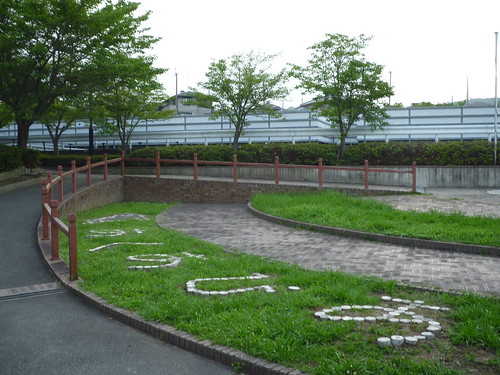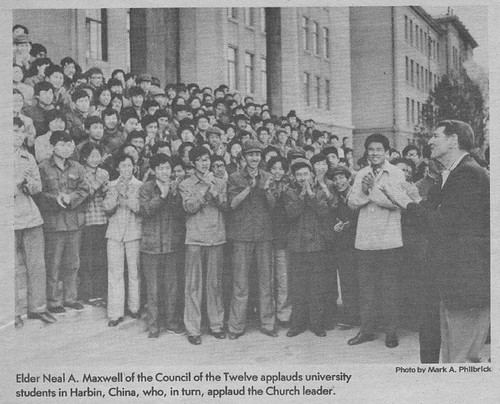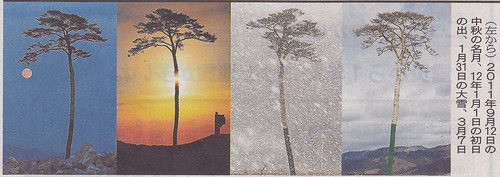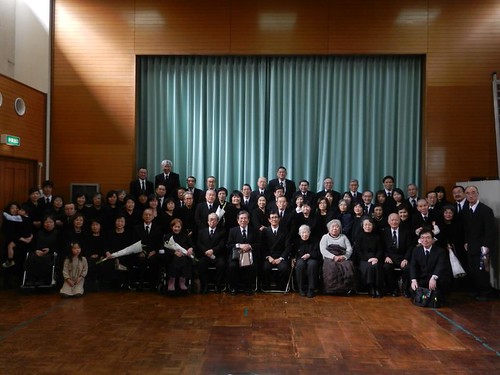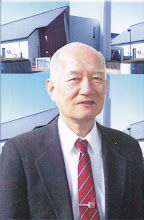I found a very good picture on a Chinese SMS site, QQ. Faces of deciples and Jesus are drawn to show western features, but the landscape behind is typically Chinese.
Saturday, November 24, 2012
Monday, October 22, 2012
In Sophia Cathedral, Harbin, China
I felt I was treated with a wonderful singing group in this museum-turned cathedral. I would like to visit Harbin again.
Thursday, August 23, 2012
A book to add to libraries
I am about to finish writing a draft of my book on Mormonism in Japanese. It looks like a collection of my research papers, so I hope it will be edited to look more readable. The tentative title would be, "Mormonism I now know: a story by a convert who tries to be intellectually independent."
Friday, July 27, 2012
Mountain Meadows Massacre Memorial
As the photographer says, the incident was the most un-Mormon tragedy. I am going to mention it in my forthcoming book on Mormonism in Japanese.
Monday, May 21, 2012
'Aqua-pia' in a park green. Takatsuki, Osaka, Japan
I go to this small park near my house almost daily to tend the garden by weeding out. A voluntary work I cherish.
Friday, May 04, 2012
A house in Osaka, Japan
I live in this house with my wife. It is located in Takatsuki, Osaka. I am enjoying my retired life, reading, writing, attending various lectures, and taking a walk.
Thursday, March 29, 2012
Students in Harbin and Elder Maxwell
Back in 1982 Elder Neal A. Maxwell visited Harbin, China with Lamanite Generation performing group of Brigham Young University. He and students exchanged applaud. I found this photo while preparing for a presentation on lds presence in China in Calgary this June.
Saturday, March 24, 2012
一本松 A Single Tree Survived
After the devastating 'tsunami,' a single pine tree remained alive for more than a year. But as sea water damaged its root, the community nearby of Northern Japan gave up the idea of protecting the tree. From its seeds people try to take over this strong tree's life into future. (The pictures are taken from Asahi Newspaper. A correspondent's name, Atsushi Yamanishi, is given in the photo article.)
Tuesday, March 20, 2012
Monday, June 21, 2010
Some Haikus in English Translation
Spring is here: almost everyone is out taking a walk.
--- Jia Haonan
Ever cherished but short-lived is our youthfulness.
--- Guo Tian-yi
Among friends the principles of trust should abound.
--- Chu Yuhang
Reflected up-side-down upon the surface of the lake is your face.
--- Ning Yue
Right at this moment, I long to be with you, my beloved!
--- Wang Yuting
Translation is done to transfer the meaning, rather than the form (number of syllables). (Translation is by Jiro Numano, the teacher)
Thursday, February 04, 2010
Preparatory note of apology for 731st force operations
“As a Japanese, I feel very sorry for the fact that Japanese army developed such grievous weaponry, and that victimized countless citizens in its process. I should like to apologize those victims and their families from the bottom of my heart. I know that there is no room for any excuse. I am really sorry. I suppose the wound the Chinese people suffered and the grudge as well as unpleasant feelings you have toward Japan would not disappear easily. Though I was not involved in the damaging operations directly, I wish I could make up for the harm in the range of my capacity. And as one of the pro-China Japanese, I would like to cherish the close affinity I feel toward Chinese people and try to advance harmonious and cooperative relationships between the two nations.”
Friday, January 22, 2010
Saturday, November 22, 2008
A Feeling on the Result of US Presidential Election
A sigh of relief I breathed
at the long-awaited change of the chief of state.
With the people of the whole world over
I yelled with delight.
At long last, the leader of America is going to be replaced
after the long four years. Even though the head of state there
be changed, what the current super power will do, insist, and
require would not change in essence. However, I would like to
have hope that it would at least shift its political postures
and would not make the same kind of mistakes the predecessor
(or the incumbent) has made.
Friday, November 09, 2007
lds in Asia
1 Almost Faye-mous 2.3 URL http://fayemin.com/blog Beijing, China
2 jacky chin's journal URL http://jackychin.blogspot.com Ipn Perak, Malaysia
3 Curbside Puppet URL http://www.blogger.com/profile/00173985274383203868
Philippine
To be added. (If viewers would like to add the list, please assist me. Thanks.)
Friday, November 02, 2007
A poem read before BYU students
I am not here by accident.
Born in Shanghai, China, a few days before Japan attacked Pearl Harbor,
I was taken back to Japan by my mother in 1945.
The packed train we rode in passed Hiroshima to Nishinomiya, a suburban town near Osaka. I was three.
A few months later an A-bomb was dropped in Hiroshima.
As an elementary school pupil, I saw two documentary movies on Hiroshima's tragedy.
The films were very vivid and powerful for a small boy.
Horrible afterimages stayed in my mind.
I began to find special meaning in the message Hiroshima has been sending out to the world.
Whenever I see the atomic dome, somehow I feel a solemn atmosphere which is to be held dear.
Now, I notice the Japanese, particulary survivors of the tragedy, are beginning to say "it was against humanity and wrong for the US to have used the weapon."
What I desire of you is that you become aware of different perspectives shared by other nations.
Although I am not a native of Hiroshima, nor a survivor of the bomb, I think it is not by accident that I meet you here as one of the representatives of this city of peace.
(Read on 29 July, 2007 at an exchange meeting held at Hiroshima Kokusai Gakuin University. Eighteen students of Brigham Young University and 10 Japanese met.)
Friday, March 31, 2006
A farewell verse to a colleague
A dear colleague of ours,
You have endured a hard time
To prove to be the bright pivot.
A better future
Let us wish you and us.
To a teacher who moves to
another institution. March 2006
Tuesday, March 28, 2006
Rough-&-Ready Baptism Period in Japan
Title: The Rough And Ready Baptism Period In Japan
From 1979 to 1981, requirements for Japanese convert baptisms were loosened and area administrator pressured mission presidents to increase the number of baptisms. The result was a large number of converts who mostly left the Church. Are there still scars from this policy? How do converts from this period feel? How about the members called to visit them? How has this period affected Japanese perceptions of the Church?
Presenter: Jiro Numano
The presenter plans to publish a paper on this issue in future.
Thursday, August 11, 2005
Hiroshima: a small dialogue
Wilfried, I appreciate very much your posting this topic in an appropriate stance:
> this is not the day to analyze the chain of events that led to it nor to weigh reasons and responsibilities. Still I feel I must try to comprehend something essential, something that goes way beyond the facts and ties in with the Gospel and eternity.
> this is a day to ponder about the white doves flying over the Atomic Bomb Dome, the suffering on all sides, burned skin hanging from bodies, radiation, children, peace for tomorrow. But the scare of a future, similar to Hiroshima’s fate, is still with us, today more than yesterday.
I feel relieved to find most of the 20 comments tried to face this difficult theme sincerely.
– A Japanese member of the Church in Hiroshima.
Comment by NJWindow — 8/9/2005 : 7:04 am
It certainly was a surprise to receive this comment from a Church member in Hiroshima. Thank you so much. Also thank you for your generosity and kindness, because some of the previous comments were perhaps somewhat hurtful and unnecessary in this thread. But, indeed, the overall tone of the participants is one of sober commemoration and of gratitude for the Spirit that binds us all, whatever our nationality and whatever the past of our countries. We greet you, Hiroshima. And, appropriately, we add Nagasaki today in our thoughts.
Comment by Wilfried — 8/9/2005 : 11:40 am
Friday, March 11, 2005
100 Years of Japan Mission
100 Years
of Japan Mission
by Jiro Numano (Mormon History Association Newsletter, Oct. 2001)
A symposium was recently held in Japan to commemorate the centennial of the Japan Mission of The Church of Jesus Christ of Latter-day Saints in Tokyo on
September 8, 2001. A small but interested group of people attended the meeting held at Shinagawa Hoken Center under the sponsorship of Jiro Numano, a faculty member of Sociology at Hiroshima Kokusai Gakuin University and a member of MHA.
Numano spoke about "The Reception and Indigenization of Christianity in Japan," and showed that LDS Church did not lose much time in following the first group of Christians who came to Japan in 1859 and others thereafter. Then, in view of the very low percentage of Christians in current Japan, he presented types of reception and indigenization of Christianity: one, sinking down under the Japanese mental framework and lifestyle; two, isolation from Japanese society by sticking to Western service modes and religious lifestyle, discarding Japanese way of thinking; three, confrontation against old Japanese values that contradict Christian teachings and; four, grafting Christianity onto positive Japanese values. Numano suggested that LDS Church now seems to turn to the last type as revealed in some reports issued by the Church.
Yutaka Inaba of the Church Education System next presented a summary on "The Growth, Establishment and Recent State of the Church in Japan." After reviewing statistical data, he noted the remarkable role of the baby-boomer generation born in the late 1940s who converted to the Church and constituted the important core of the membership here. "We may be close to the stage of maturity," he said, "but we should anticipate somewhat difficult future ahead as Japanese population will stop increasing in the 21st century."
Kazuo Takemura of Rissho University in Tokyo reported from his Ph.D. dissertation, "A Geographical Study on the Proselytizing and Reception of the Church of Jesus Christ of Latter-day Saints in Japanese Provincial Cities." He demonstrated the remarkable difference of motives of conversion and retention ratios according to the geographical regions which have different Buddhist backgrounds. His introduction of "life history" interviews with those converts interested audience. As Mr. Takemura was an invited speaker from outside the Church, he attracted attention and was asked many questions from those who attended the symposium.
October 13: “A Centennial Celebration: The History of the Church of Jesus Christ of Latter-Day Saints in Japan, 1901-2001,” a day-long academic conference focusing on the history of the Church in Japan and the largest Japanese mission reunion ever will be held this Saturday at Brigham Young University. See http://japanconference.byu.edu on the Internet or contact chair Reid L. Neilson at rlneilson@msn.com
Sunday, February 27, 2005
Passing of Hugh Nibley
Jiro Numano
Professor of English as a Foreign Language
Hiroshima Kokusai Gakuin University
Hiroshima, Japan




